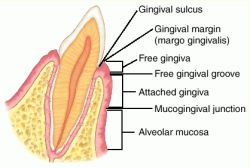Gingival crevicular fluid is a fluid occurring in minute amounts in the gingival crevice, believed by some authorities to be an inflammatory exudate and by others to cleanse material from the crevice, containing sticky plasma proteins which improve adhesions of the epithelial attachment, have antimicrobial properties, and exert antibody activity.

It has an extremely various composition:
- polymorphonuclear leukocytes (Neutrophil granulocytes);
- lymphocytes;
- monocytes;
- organic ions
| ion | mmol/lit |
| sodium | 91.6 + 31.1 |
| potassium | 17.4 + 11.7 |
| calcium | 5.0 + 1.8 |
| magnesium | 0.4 + 0.2 |
| phosphate | 1.3 + 1.0 |
- bacterial products;
- epithelial cell (from tissue desquamation)
The composition of this fluid is similar to saliva composition.
Functions
- protective effects
- clearance of cells and potentially dangerous bacterial molecules;
- antibacterial action of immunoglobulins;
- (plaque formation induced by calcium ions on the gingival margin)
- negative effects
- tartar formation induced by alcaline phosphatase;
- proteolytic enzyme are dangerous for the gingival sulcus and the other gingival tissues
The production of gingival crevicular fluid seems to be associated with inflammatory processes and not a product of a healty tissue.
Some of its components are probably more involved than others in the developement of the periodontal desease:
Artificial Saliva, 2005